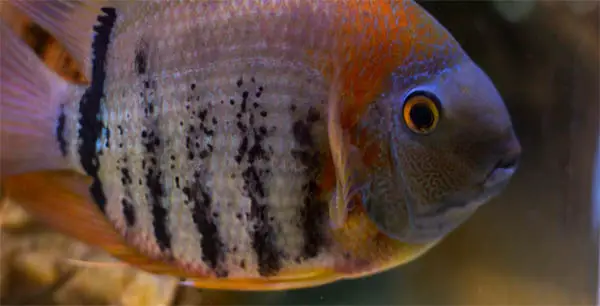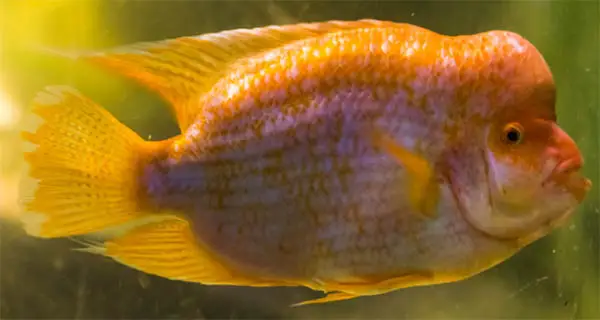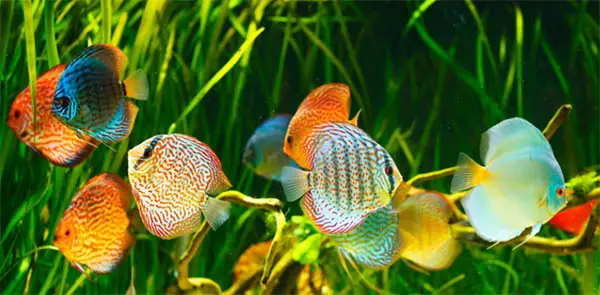I was a 14 years old when I got my first pair of severums. Prior to that I’d only kept things like goldfish, dojo loaches, and the odd catfish or two. So you can imagine my amazement when I witnessed the magic of my severums changing color on a regular basis.
That’s right, severum’s change color. A lot.

They can get paler, they can get brighter, they can show dark bars on their flanks, and they can turn almost black!
What Does It Mean When Severums Change Color?
Severums—like many cichlids—change color to indicate to other fish around them or in response to influences in their environment.
Breeding
It’s possible that a healthy female severum getting darker—almost black—is a sign she is preparing to lay eggs. It’s not only severums, lots of cichlids change color (often getting darker) when they get in the mood to reproduce.

https://commons.wikimedia.org/w/index.php?curid=1722875
This severum is quite dark and also showing barring on its side.
To us as aquarium hobbyists, the potential that your severums are preparing to breed is one of the more positive and interesting explanations for their color change.
How Do I Know If My Severums Want To Breed?
Turning dark isn’t the only clue your severums might be ready to breed, you can look for other hints to corroborate this.
First and foremost, you should look for signs that two of your severums have “paired up”. If they have paired up it’s usually quite apparent because they will move around the tank together and interact with each other i.e. lip locking, mild sparring, etc.

https://commons.wikimedia.org/w/index.php?curid=5625696
There is always a genetic component to severum coloration. This fish, for example, has red above the gills / behind the eye. Only fish with the genes for this coloration can display it.
In addition to this, a pair of severums will identify a breeding site in the tank and defend it quite diligently. Severums are substrate spawners; this means they typically select a flat surface close to the bottom of the tank and lay their eggs on it. They may also dig in the substrate to create a pit for the fry to stay in once they hatch.
Stress Can Cause Your Severum To Darken
Severums darkening for short periods of time is usually a consequence of a temporary mood rather than a serious problem. However, if the fish stays very dark for extended periods of time then it could be an indicator of something you need to address. It could mean your fish is in distress.
Fighting
Cichlids are territorial fish with more complicated behavior than your average tetra or danio. If you have either, a) a group of different cichlids in your tank, or b) multiple severums in your tank, then your severum turning black could be caused by fighting.

A submissive cichlid in an aquarium setting can quickly become chronically stressed. In severums, a darkening of the coloration is a possible indicator of a frightened fish.
Nowhere To Run, Nowhere To Hide
Bear in mind, in the wild a submissive fish can easily escape an adversary by simply swimming away. But, in your fish tank, your severum is forced to stay in close quarters, living virtually on top of its tormentor.
How To Put A Stop To The Fighting
When it comes to resolving aggression between your cichlids you have a number of options available.
First and foremost, you should be realistic about possibly having to re-home the victim of fighting. Or, if you are too attached to the fish to find it a new home, you might need to provide it with a new aquarium where it can live in peace without being terrorized by an aggressive, dominant fish.

Before you follow through with re-homing the fish, you can try a “rescape”. This means re-arranging the decorations—i.e. the “aquascape”—in your fish tank. This will upset any established territories in the tank and cause the dominant fish to be less aggressive. Keep in mind though, this may only be a temporary solution as a dominant and aggressive fish might emerge again once they become familiar with the new configuration of their surroundings.
If you do decide to rearrange your tank as a solution to aggression, you should position the decorations in your tank with the goal of providing blocks in the line of sight. What this means is that you want to provide hiding spots for your fish. But, it’s more than just that: you also want spots in the tank that aren’t necessarily hiding spots, but are out of sight to a fish at the other end of the tank. Broken terracotta flowerpots are an excellent choice for this.
I have written an article on how to manage aggression between cichlids, you can find it here.
Check water parameters
Fighting and aggression between your fish isn’t the only thing that can cause your severum to darken as a result of stress; poor water quality can also be the cause.

Ammonia and Nitrite
And because of that, I recommend checking your tank water for any ammonia or nitrites. If either of those are present in your water then your filter’s bacteria colony isn’t doing what it should be. This could be because your tank isn’t cycled yet, or maybe you’ve had a bacteria crash. This, however, is unlikely in an established aquarium—especially if none of the other inhabitants are showing signs of poor health.
Nitrate
While you’re testing for ammonia and nitrate, you should also test for nitrate. Unlike ammonia and nitrite, nitrate isn’t really that dangerous for your fish. But, if you find that nitrates are highly concentrated then you might need to up your water change regime to keep the water nice, clean, and healthy for your severum.
But What About pH?
And as for pH, while it could be an issue, it is—in my opinion—unlikely to be the cause of your fish being stressed and changing color. Your tap water is almost certainly a tolerable pH for your severum. Furthermore, most severums in the hobby are captive bred and are therefore very tolerant of a wide range of pH values.
It’s true that keeping an eye on your pH can be important as a fishkeeper, but I wouldn’t expect that it would be the cause of your severum darkening.
Consider Tank Mates (Think: Dither Fish!)
We’ve already talked about how aggression between cichlids can be a source of stress, but you should also consider how your severum’s other tank mates might be affecting its mood.
Some individual cichlids are habitual hiders, they’re just timid boys or girls. Much in the same way we humans might be extroverts, or we might be introverts.

To solve this you might need to introduce “dither fish” to make your severum feel more comfortable. Dither fish are fish we can add to our tanks to encourage other fish to come out of hiding.
When it comes to shy cichlids, the best dither fish are non-aggressive, schooling fish.
What We Can Learn From Discus Keepers
The use of dither fish is very common with discus. Cardinal tetras are the quintessential dither fish for discus keepers. When the discus see that there is a school of cardinal tetras in the area, they assume that they are safe from predators.

You can use this same approach with your severum if you believe you have an overly sheepish individual. Although, cardinals might be a bit small to be kept with severums—they might get eaten. Therefore, consider larger tetra species or, perhaps, plump for some less nippy barb species as potential dithers.
What If It Turns Out My Severums Are Breeding?! What Next?!
I mentioned it earlier: it might be that your severums are breeding. In which case, your female is dark because she is showing “breeding dress”.
If this is the case you might need to consider what to do when the eggs are laid.
You have two options: to intervene, or not to intervene. That is the question.
To be specific, you have the option to intervene and help the fish keep the eggs and raise their fry. Or, you have the option to ignore the situation and allow either the parents or other tank inhabitants to eat the eggs or fry.
Breeding Cichlids = Increased Aggression
If you decide you want to experience the total fun of breeding your fish then you’ll have to accept that your severums will find it much easier to lay, defend, and raise their babies in a tank of their own—no tank mates.
Some people do have some success breeding fish in community tanks, but when it comes to cichlids, it’s important to remember that their aggression levels increase significantly when defending offspring.
And in spite of increased parental aggression, there’s still a very good chance that—in the confines of a community aquarium—they’ll fail to protect their offspring. Lots of fish are excellent at eating eggs, the perfect example would be any type of pleco you might have. When the lights go out at night your bristlenose (or any pleco for that matter) will have an easy time sneaking up on the parents and devouring the eggs.
What The Heck To Do With The Babies?
You might start out worrying why one of your severums is dark, and end up worrying what the heck you’re gonna do with hundreds of baby severums!

Some people see their fish on par with dogs, cats, guinea pigs, horses, or whatever! While, some fishkeepers see them as more expendable. I’m in the former camp, I hate to lose a fish of any kind, I detest the notion of feeder fish, and if I breed my fish I hate losing any of the offspring.
So, if you’re like me, you have to address that question “what the heck am I going to do with hundreds of baby severums?!” For people who share my perspective about the value of a fish’s life then there’s a responsibility to find homes for the fish you breed.
Severums aren’t exactly neon tetras, they get fairly big and can be somewhat aggressive. But, on the other hand, they’re not oscars or red devils either. For that reason, you might encounter some minor challenges finding homes you can be confident are appropriate for your fry.
Try Your Local Fish Store
In some circumstances your local fish store will happily give you store credit for your juvenile severums. Just think, if those baby severums sell well, it could be the start of a mutually beneficial relationship with your LFS. Eventually they might be willing to pay you in cash rather than store credit.
Don’t Forget Social Media
You can also use social media to find homes for your fish. The obvious choice is Facebook, but don’t rule out platforms like Twitter and Instagram.

The online fishkeeping community is robust and friendly in my experience. So, you’ve got a good chance of finding local aquarists who want your fish. In addition, you might turn out to meet friends that you can share the hobby with in the future.
Before Social Media We Had Aquarium Societies
And that brings me nicely on to aquarium clubs and societies. Lots of areas have them, and they’re worth joining as a place to buy, sell, and trade your fish. In addition to that, aquarium clubs often have fun events and pay speakers to give talks on various topics. The Aquarium Co-op website has a great list of aquarium clubs here.

Conclusion
In conclusion, your severum can darken its coloration as a way of indicating it is ready to breed. Darkening in severums could also indicate stress from fighting, poor water quality, or ill health.
Regardless of the cause, it usually isn’t a serious sign. Severums change color all the time. You just need to keep the fish’s water clean and ensure it isn’t being bullied by other fish.
Keep up the good work and your severum will be happy and healthy for years to come!
Don’t Forget Diet!
If we want our fish to look good, sure, we gotta have good genetics, and decent water quality. But, how good is the food you’re feeding your fish? Are you feeding them the good stuff?
Well, I put together a list of foods I use and that I think are the best. Also, I did quick reviews and explanations of them to go with it.



